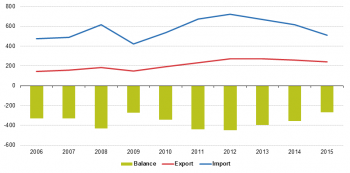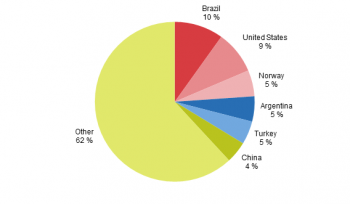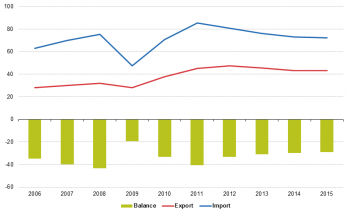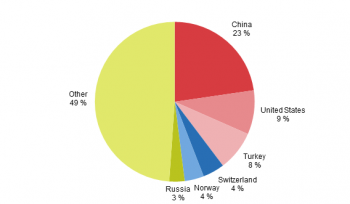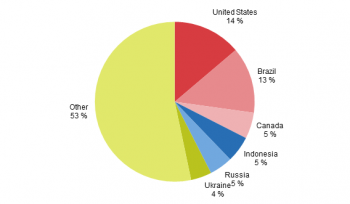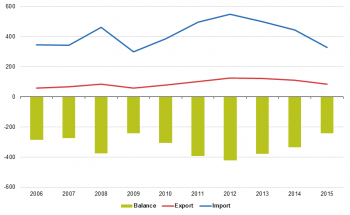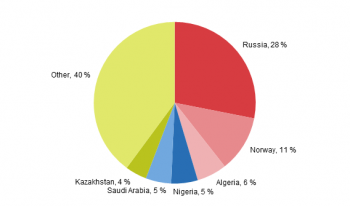Archive:Extra-EU trade in primary goods
- Data from May 2017. Most recent data: Further Eurostat information, Main tables and Database. Planned update May 2018
This article focuses on the structure and evolution of the European Union (EU) international trade in primary goods: imports and exports at EU level. Primary goods, also called commodities, are goods sold for production or consumption just as they were found in nature; they include crude oil, coal, iron, and agricultural products like wheat or cotton.
The Standard international trade classification (SITC) distinguishes five main categories (sections) of primary goods:
- food and live animals (SITC 0 );
- beverages and tobacco (SITC 1);
- crude materials, excluding fuels (SITC 2);
- mineral fuels (SITC 3);
- animal and vegetable oils, fats and waxes (SITC 4).
Sections 0 and 1 are often grouped together as 'food and drink', 2 and 4 as 'raw materials'.
Main statistical findings
In 2015 the EU imported EUR 508 billion of primary goods which was almost 30 % of total EU exports. This was 11 % less than in 2012 when imports peaked at EUR 721 billion. This decrease was mainly the result of a contraction of imports in energy products which dropped by EUR 219 billion, from EUR 547 billion in 2012 to EUR 328 billion in 2015, mainly due to a decrease in prices. There was a much smaller decline of EUR 8.6 billion in raw materials while food and drink imports increased by EUR 15.0 billion.
In 2015 the exported EUR 242 billion of primary goods which was 13 % of total EU imports. This was 2.7 % less than in 2012 when exports peaked at EUR 272 billion. This decrease was mainly the result of a contraction of imports in energy products which dropped by just over EUR 40 billion, from EUR 126 billion in 2012 to EUR 85 billion in 2015, mainly due to a decrease in prices. There was a much smaller decline of EUR 4.3 billion in raw materials while food and drink imports increased by EUR 14.3 billion. The EU shows a persistent deficit in trade of primary goods, mainly driven by the deficit in energy products, which tripled between 2002 and 2013 but has dropped sharply since then.
Food and drink
Product group ‘food and drink’ (SITC Sections 0 and 1) includes agricultural products such as food and live animals, beverages and tobacco.
Trade in food and drink rapidly increased from 2006 to 2015 with a small dip in 2009. The EU was traditionally a net importer, but records a trade surplus since 2012.
In imports the most important products are fruits and vegetables, fish, coffee and tea. The USA is the main importer of food and drink from the EU with a 15 % share. It is followed by China, Switzerland, Japan, Russia and Norway.
In exports, beverages are the most important individual products within the group, accounting for around a quarter of the total. Other main products include cereals, fruits and vegetables and dairy products. Brazil is the main exporter of food and drink to the EU with a 10 % share. The other main suppliers of food and drink are the USA, Norway, Argentina Turkey and China. The six main exporters of food to the EU have a slightly higher share (62 %) than the six importers of food from the EU (60 %).
Raw materials
Raw materials (SITC Sections 2 and 4) include non-manufactured goods like oilseeds, cork, wood, pulp, textile fibres, ores and other minerals as well as animal and vegetable oils.
The EU has an ongoing trade deficit; both imports and exports rapidly recovered from the low levels registered in 2009 but have fallen in recent years, probably due to declining prices. The trade deficit which peaked in 2012 at EUR 40 billion has decreased to 29 billion in 2015. EU imports and exports in raw materials are relatively low as they make up 4.2 % of total EU imports and 2.4 % of total EU exports.
In 2015 metal ores are by far the most exported raw material. The largest share (23 %) goes to China. The United States (9 %) and Turkey (8 %) follow at some distance. Switzerland, Norway and Russia complete the top 6. Together they account for 51 % of all imports.
Just like in export, the great majority of imports were metal ores, with a share of 42 %. Other products to record a large share of imports include vegetable fats and oils and oilseeds. Traditionally Brazil was the major exporter of raw materials to the EU. However in 2015 they were surpassed by the United States who had a share of 14 % which was slightly higher than Brazil's share of 13 %. Canada, Indonesia, Russia and Ukraine are the other sources of imports. The main six countries account for 47 % of EU imports.
Energy products
The main goods of energy products (SITC Section 3) are crude oil, refined petroleum products, coal, gas and electric current.
The EU is dependent on imports of energy products. This has led to a structural trade deficit, which reached a record level of EUR 421 billion in 2012. The value of imports closely follows the price of crude oil which explains the decline of the trade deficit in recent years. From 2006 to 2015 EU imports of energy products have fluctuated more than exports.
The majority of EU exports are refined petroleum products. The biggest destination country is the USA, which accounts for about 13 % of total exports. The market of EU exports is very fragmented; the top 6 destinations only account for a quarter of all exports.
The most imported goods are petroleum and petroleum products, mainly crude oil. Most of the remaining falls to gas and coal. The major energy providers for the EU are Russia and Norway, which made up almost 40 % of the imports in 2015. Algeria, Nigeria, Saudi Arabia and Kazakhstan all have share between 4 and 6 %. The combined share of the top 6 is 60 %.
Data sources and availability
Data sources
EU data come from Eurostat’s COMEXT database. COMEXT is the Eurostat reference database for international trade. It provides access not only to both recent and historical data from the EU Member States but also to statistics of a significant number of third countries. International trade aggregated and detailed statistics disseminated from Eurostat website are compiled from COMEXT data according to a monthly process. Because COMEXT is updated on a daily basis, data published on the website may differ from data stored in COMEXT in case of recent revisions.
EU data are compiled according to community guidelines and may, therefore, differ from national data published by Member States. Statistics on extra-EU trade are calculated as the sum of trade of each of the 28 Member States with countries outside the EU. In other words, the EU is considered as a single trading entity and trade flows are measured into and out of the area, but not among Member States within it the EU.
Unit of measure
Trade values are expressed in billions (109) of euros. They correspond to the statistical value, i.e. to the amount which would be invoiced in case of sale or purchase at the national border of the reporting country. It is called a FOB value (free on board) for exports and a CIF value (cost, insurance, freight) for imports.
Context
Primary goods belong to three categories of products: agricultural products, raw materials and energy. The EU is the world’s foremost trader in agricultural products. Europe imports mostly basic agricultural commodities, but its exports are based on high-quality farm products and other processed agricultural products. Recognising the crucial role that agriculture plays in many developing countries, the EU has granted extensive market access to agricultural imports from developing countries. The European Union, due to the characteristics of the European industrial base, is highly dependent on imports of raw materials for its competitiveness and for its economic development. An increase in worldwide demand in raw materials in the future is expected; this increase will be largely due to economic growth in emerging economies. The European Union is also dependent on imports of energy from other countries. One of the key priorities is therefore to run a strategic international energy policy which leads to stable and secure supply routes.
See also
- Extra-EU trade in goods
- Extra-EU trade in manufactured goods
- Extra-euro area trade in goods
- International trade in goods
Further Eurostat information
Data visualisation
Main tables
- International trade data (t_ext)
- International trade long-term indicators (t_ext_lti)
- International trade short-term indicators (t_ext_sti)
Database
- International trade data (ext)
- International trade long-term indicators (ext_lti)
- International trade short-term indicators (ext_sti)
- International trade detailed data (detail)
Dedicated section
Methodology / Metadata
- International trade in goods statistics - background
- International trade in goods (ESMS metadata file — ext_go_esms)
- User guide on European statistics on international trade in goods
Source data for tables, figures and maps (MS Excel)
Other information
Legal background
- Regulation (EC) No 471/2009 of 6 May 2009 on Community statistics relating to external trade with non-member countries
- Regulation (EU) No 92/2010 of 2 February 2010 implementing Regulation (EC) No 471/2009, as regards data exchange between customs authorities and national statistical authorities, compilation of statistics and quality assessment
- Regulation (EU) No 113/2010 of 9 February 2010 implementing Regulation (EC) No 471/2009 , as regards trade coverage, definition of the data, compilation of statistics on trade by business characteristics and by invoicing currency, and specific goods or movements.
